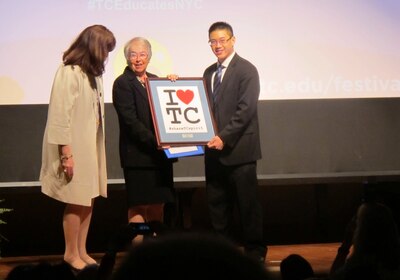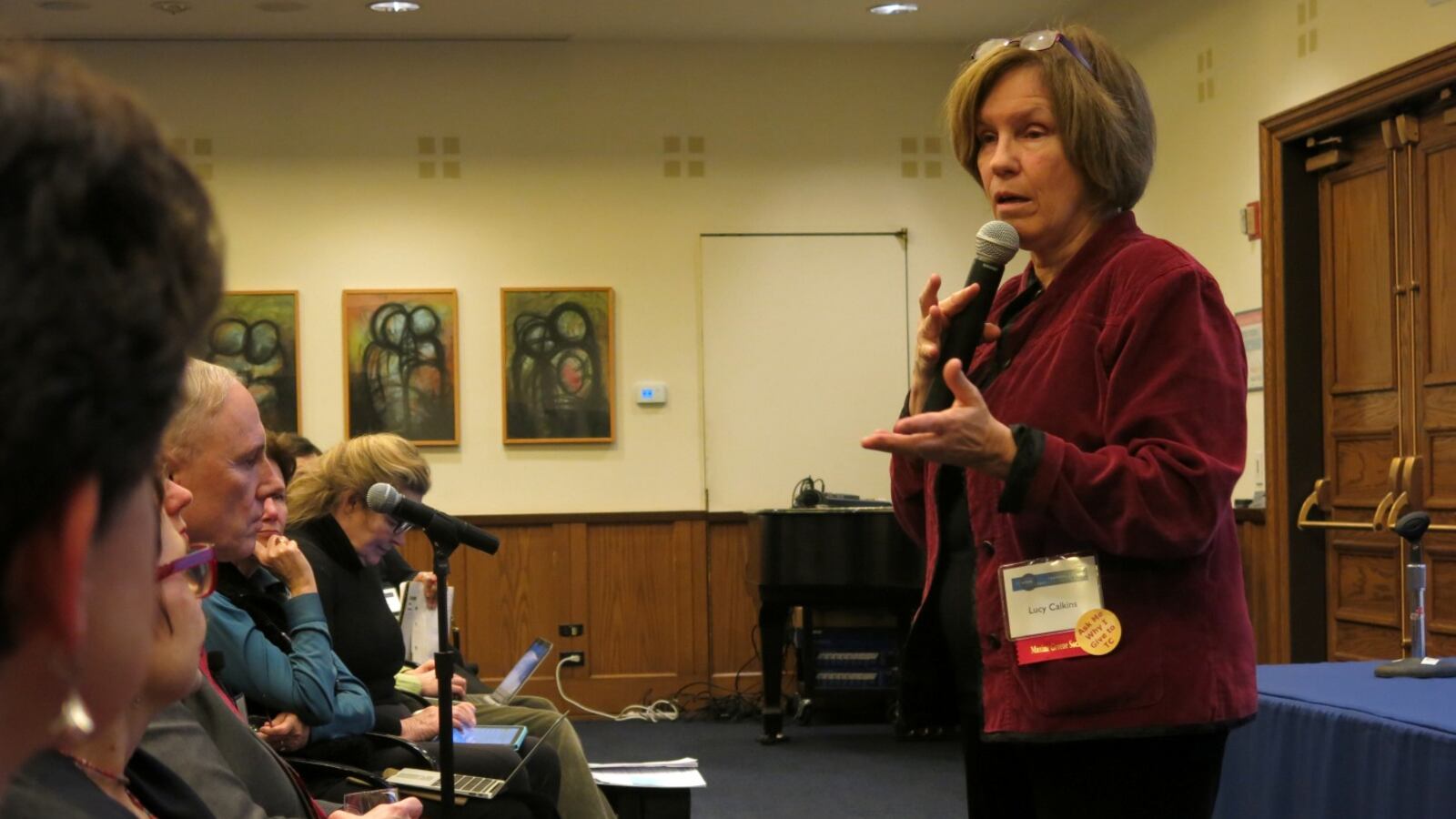The influential Teachers College professor Lucy Calkins was nearing the end of a talk about the new Common Core reading standards earlier this year when suddenly she let loose some barbed remarks.
Her target was David Coleman, the president of the College Board and one of the Common Core’s lead writers, whom she called “an expert in branding.” She later described a well-known model lesson by Coleman where high school students are asked to pore over the three-paragraph Gettysburg Address for several days, parsing the meaning of the individual words and phrases in the speech.
“To me, it basically represents horrible teaching,” Calkins said at the January event.
The founding director of the decades-old Teachers College Reading and Writing Project, Calkins has helped train thousands of teachers and produced widely used teaching materials. More recently, she has watched with dismay as New York school officials, in their quest to usher in the Common Core, have embraced new literacy curriculums inspired by Coleman’s vision.
But in January, Calkins’ longtime friend Carmen Fariña, who has called Calkins her mentor, was appointed head of the city school system. The two met privately at the Department of Education headquarters after Fariña became schools chancellor.
Around that time, Calkins wrote to Fariña urging her to resist the curriculum guidelines written by Coleman and his team, Calkins said in her speech.
“Please, Carmen,” Calkins said she appealed to Fariña, “protect the Common Core from the documents surrounding it, that are people’s interpretations of it.”
Now, Fariña has the power to reimagine the way educators across the city teach reading and writing in the age of the Common Core. Already, the chancellor has promised a top-to-bottom review of the city’s recommended curriculums. And to lead a citywide Common Core literacy training next month, her administration brought in Calkins’ group.
But some critics say that parts of Calkins’ approach and the Common Core are incompatible. The prospect that Fariña’s ascension could expand Calkins’ influence over the school system has already unsettled some of of them, including New York University education professor Susan Neuman.
“I think that’s scary,” Neuman said, “and devastating.”
An influential approach, with its fair share of critics
Some of the city’s top-performing schools — including Manhattan’s P.S. 6, where Fariña was principal, and those in the Brooklyn district where she was superintendent — follow Calkins’ approach. The approach, which falls under the heading of balanced literacy and is sometimes referred to as the workshop model, is known for having teachers corral students onto carpets for brief reading-skill lessons and then send them off to practice with books the students choose.
In 2003, then-Chancellor Joel Klein ordered most schools to adopt balanced literacy and hired Calkins’ group to train teachers. When Fariña became a deputy chancellor the following year, she oversaw the balanced literacy push.
During the long-running “Reading Wars,” critics attacked balanced literacy for what they considered too little teacher-led instruction, especially in phonics. But they have found new ammunition in the Common Core.
First, they say that balanced literacy’s insistence that students spend much of their time reading self-selected books runs counter to the standards’ demand that all students read texts at and above their grade level. Next, they say that the balanced literacy model can strand students without the background information they need to make sense of specific texts — neglecting the standards’ insistence on a “content-rich curriculum.”
“There’s consensus among cognitive scientists that background knowledge is essential for reading comprehension and you don’t get that in balanced literacy,” said Sol Stern, a senior fellow at the Manhattan Institute and longtime critic of Calkins’ approach. “It focuses on the skills divorced from any content.”
That criticism registered with Klein, who launched a pilot program in 2008 to compare schools using balanced literacy and other methods to ones using Core Knowledge, a curriculum that emphasizes the teaching of background information. The study found greater gains in the schools using Core Knowledge, which the state and city went on to endorse as Common Core-aligned.
Calkins has criticized the pilot study as flawed and too limited. In an interview, she defended using ability-matched books, which she said enables struggling readers to work their way up to grade-level texts. And she said that balanced literacy includes “shared texts” at or above grade level, which classes read together and teachers supplement with background information.
But even as some have suggested that Calkins’ approach clashes with parts of the Common Core, Calkins has publicly embraced the standards, co-authoring a top-selling book on the Common Core and teaching educators how to meet them. Scores of city schools still work directly with Calkins’ group to implement her brand of balanced literacy.
“I have no question in my mind that balanced literacy well done can absolutely help children reach the standards as well as anything,” said Chris Napolitan, an assistant principal at Brooklyn’s P.S. 10, which follows Calkins’ literacy model.
A model of Common Core reading takes hold
Whereas Calkins’ sway over instruction is easily detectable in the many classrooms that use her materials and methods, David Coleman’s impact has been more indirect.
This was apparent a few years ago when New York asked publishers who were vying to create new Common Core teaching materials for the state to complete an unusual task: analyze Coleman’s Gettysburg Address lesson. They were also asked to create teacher-training materials based on Coleman’s model lesson.
Those publishing requirements, tucked into the state’s request for Common Core curriculum proposals, were just one sign of Coleman’s double influence: After he helped craft the standards, he and a group he co-founded guided education officials as they worked to make sure the standards reached classrooms.
One way he and Susan Pimentel, another Common Core author, did that was by developing guidelines for states and school districts to determine whether teaching materials are properly aligned to the standards. The guidelines were published soon after the standards, and they detail the work students should do in class, much of it centered on reading challenging texts multiple times and analyzing them.
New York State officials told would-be curriculum developers to align their materials to the guidelines, known as the Publishers’ Criteria. City officials then used the guidelines to evaluate dozens of existing literacy programs, eventually endorsing four as Common Core-aligned.
The city commissioned the publishing giant Pearson to design one of the endorsed programs, a new curriculum called ReadyGen, to match Coleman’s guidelines. The “Publishers’ Criteria were very prominent” in the design process, said P. David Pearson, a literacy professor at the University of California, Berkeley, who helped write the ReadyGen curriculum.
“We as districts have chosen to embrace the Publishers’ Criteria because our teachers and students have a right to excellent materials,” then-Chancellor Dennis Walcott said in a 2012 announcement.
Eventually, nearly 90 percent of elementary and middle schools that bought new materials last year ordered from the city’s recommended curriculum list, which did not include Calkins’ materials.
With officials following Coleman’s lead, Calkins cries foul
Recently, Calkins has been firing back. After the city declined to endorse her materials last year, Calkins spoke to a group of principals whose schools follow her approach, challenging the prominent role that Coleman, Pimentel, and their group have played.
“The Common Core I believe is a really precious thing,” she told them. “And I don’t want it to go down by equating it with the Publishers [Criteria],” which, she added, “was written by just two people who are not educators.”

In their 2012 book about the Common Core, Calkins and her co-authors argued that the Publishers’ Criteria “directly contradict” the standards’ premise that some instructional decisions be left to educators. They also pointed out that Student Achievement Partners, a nonprofit founded by Coleman, Pimentel, and another Common Core writer, received an $18 million grant to guide implementation of the standards.
In her speech this January, Calkins argued that Coleman’s Gettysburg Address lesson violates principles valued by “experienced educators”: it limits student choice, gives short shrift to reading strategies, and ignores students’ interests and skill levels. Echoing other critics, she noted that the lesson’s directions tell teachers to “plunge” students into the speech without explaining its context, forcing students “to rely exclusively on the text.”
“Until you have a whole city teaching that way and you get unbelievable results,” Calkins said, “I don’t think you create a curriculum based on it.”
Coleman declined to be interviewed for this story. Pimentel, however, provided a five-page rebuttal to Calkins’ critiques.
She argued that the Publishers Criteria is a tool for curriculum developers, but not a curriculum, and “does not usurp teacher choice.” She noted that the Gettysburg lesson was only the first of many model lessons her group created, and that it was designed for teachers to adapt. And she said this “close reading” approach, which privileges the words on the page over students’ prior knowledge, is effective.
Calkins’ group, meanwhile, “has little to no evidence for the effectiveness of its approach, in spite of an over 30 year existence,” Pimentel wrote.
In her talk to principals last year, Calkins faulted the state for asking curriculum developers to adhere to Coleman and Pimentel’s guidelines. She added that she had assigned a half-dozen staff members to analyze the state-commissioned reading materials, which are posted on a state website called EngageNY.
“We’re taking on Engage New York,” she told the group.
A state education department spokesman noted that many states and districts used the Publishers’ Criteria to guide their curriculum decisions.
Calkins also helped launch an online forum for teachers to critique the state’s new Common Core reading test, which Pearson designed. In her January speech, she criticized the test’s Coleman-inspired emphasis on close reading, which she said forced students to repeatedly refer back to specific lines in the test passages to answer questions, rather than use their own understanding of the texts.
“Is that how we want to teach reading?” she asked.
Without committing to Calkins, Fariña signals her allegiance
As the debate over the best way to teach Common Core-aligned reading and writing drags on, Carmen Fariña could begin to settle that debate within the city’s classrooms.
So far, she has left the city’s recommended curriculum list in place for next year. But in a message to principals, she guaranteed a “comprehensive review process to identify additional Common Core-aligned instructional materials” — which could include those produced by Calkins’ group.
“I think Lucy’s program will make it back into the mix,” said Pearson, the professor who helped write the ReadyGen curriculum. He added that Calkins has a “convincing argument” that her approach can help students meet the new standards.
As Fariña reevaluates the curriculums, she has pledged to offer educators more Common Core training. Next month, that will take the form of a two-day conference for principals on middle school literacy run by Calkins’ team.
It is also possible that Fariña’s administration could encourage schools to adopt elements of Calkins’ approach even if they choose to stick with materials or teaching practices associated with Coleman’s vision.
After all, the differences between the two camps often amount to a matter of emphasis. For instance, Calkins says close reading has a place in literacy instruction, and Coleman and Pimentel’s guidelines say that students should sometimes get to read books they choose that are at their own skill level.
“Everything kids read cannot be grade-level complexity,” said David Lebin, a consultant with Student Achievement Partners. “To get a volume of reading, you have to have texts at different levels.”
For her part, Calkins seems confident that her group will play a larger role under Chancellor Fariña in helping schools meet the new standards.
“Yes, the city’s moving in our direction,” Calkins said during an interview in February. “Obviously.”
Want the latest in New York City education news? Sign up for our morning newsletter here.

